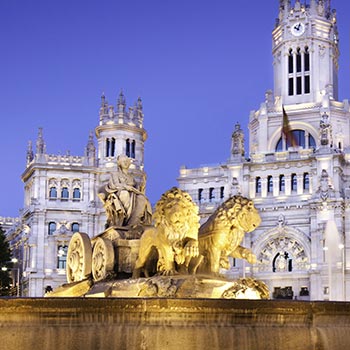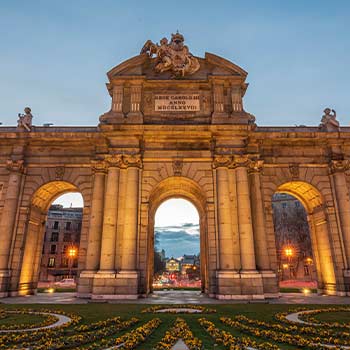Energy in Buildings
Engineering & Social Sciences Program
Madrid, Spain
Dates: 1/18/24 - 6/5/24

Energy in Buildings
OVERVIEW
CEA CAPA Partner Institution: Universidad Carlos III de Madrid
Location: Madrid, Spain
Primary Subject Area: Energy Engineering
Instruction in: English
Course Code: 16846
Transcript Source: Partner Institution
Course Details: Level 400
Recommended Semester Credits: 3
Contact Hours: 42
Prerequisites: Students are expected to have completed
Thermal Engineering
Fluid Transport and Hydraulic Machinery
Solar Energy
DESCRIPTION
1. Energy Consumption in Buildings
Building energy use, environmental impact and sustainability. Energy sources, primary/final energy, CO2 emissions. European energy performance of buildings directive (EPBD), certification of new and existing buildings, energy rating/labeling, nearly zero energy buildings (nZEB), energy audit. Energy codes for buildings, Código técnico de la edificación - Ahorro de energía (CTE-HE), ASHRAE standard 90.1.
2. Heating and Cooling Loads
Outdoor design conditions, climatic zones, typical meteorological year (TMY). Indoor comfort conditions, air quality, ventilation (CTE-HS3). Heat transfer through building envelope, insulating materials, U-value. Glazings, shadings, solar heat gains (SHGC). Passive heating and cooling, bioclimatic design. Internal loads, latent heat, psychrometric chart. Building energy simulation tools.
3. Refrigeration and Heat Generation
Vapor compression cycle, refrigerant charts, coefficient of performance (COP). Compressor, condenser, evaporator. Electric heat pumps. Electric heaters. Natural gas and fuel-oil boilers. Service water heating (SWH).
Renewable energy systems: low-temperature geothermal energy, solar thermal (CTE-HE4), solar cooling, biomass. Thermal energy storage (TES), district heating and cooling (DHC), combined heat and power (CHP). Integration in buildings.
4. HVAC Systems
Heating, ventilating, and air conditioning (HVAC), decentralized vs. centralized systems, zoning. Direct expansion systems. Air-and-water systems, fan-coils. All-water systems: pumps, pipes, radiators, radiant panels. All-air systems: air handling unit (AHU), fans, ducts, diffusors.
5. Lighting systems.
Main types of lamps. Parameters of visual comfort. Luminaries and lighting systems. Regulation of lighting (regulation 0-10 V, DSI regulation, regulation DALI).
6. Photovoltaic Systems
Types of photovoltaic cells. Installation configuration (panels, wiring, protections and investor). Resource assessment, integration into the building.
7. Power factor compensation.
Concept of power factor compensation. Estimation of consumption of reactive power. Capacitor banks and its regulation.
Building energy use, environmental impact and sustainability. Energy sources, primary/final energy, CO2 emissions. European energy performance of buildings directive (EPBD), certification of new and existing buildings, energy rating/labeling, nearly zero energy buildings (nZEB), energy audit. Energy codes for buildings, Código técnico de la edificación - Ahorro de energía (CTE-HE), ASHRAE standard 90.1.
2. Heating and Cooling Loads
Outdoor design conditions, climatic zones, typical meteorological year (TMY). Indoor comfort conditions, air quality, ventilation (CTE-HS3). Heat transfer through building envelope, insulating materials, U-value. Glazings, shadings, solar heat gains (SHGC). Passive heating and cooling, bioclimatic design. Internal loads, latent heat, psychrometric chart. Building energy simulation tools.
3. Refrigeration and Heat Generation
Vapor compression cycle, refrigerant charts, coefficient of performance (COP). Compressor, condenser, evaporator. Electric heat pumps. Electric heaters. Natural gas and fuel-oil boilers. Service water heating (SWH).
Renewable energy systems: low-temperature geothermal energy, solar thermal (CTE-HE4), solar cooling, biomass. Thermal energy storage (TES), district heating and cooling (DHC), combined heat and power (CHP). Integration in buildings.
4. HVAC Systems
Heating, ventilating, and air conditioning (HVAC), decentralized vs. centralized systems, zoning. Direct expansion systems. Air-and-water systems, fan-coils. All-water systems: pumps, pipes, radiators, radiant panels. All-air systems: air handling unit (AHU), fans, ducts, diffusors.
5. Lighting systems.
Main types of lamps. Parameters of visual comfort. Luminaries and lighting systems. Regulation of lighting (regulation 0-10 V, DSI regulation, regulation DALI).
6. Photovoltaic Systems
Types of photovoltaic cells. Installation configuration (panels, wiring, protections and investor). Resource assessment, integration into the building.
7. Power factor compensation.
Concept of power factor compensation. Estimation of consumption of reactive power. Capacitor banks and its regulation.






